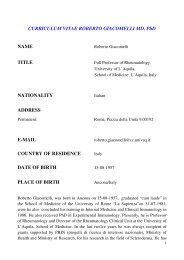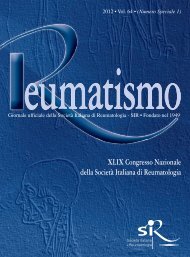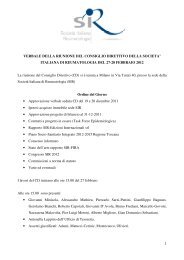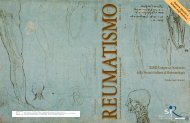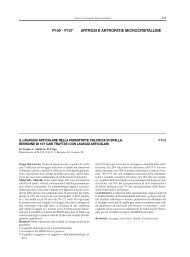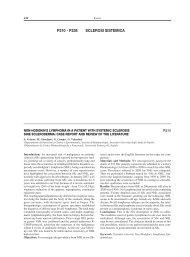M. Mosca (Pisa), R. Perricone (Roma) - Sir
M. Mosca (Pisa), R. Perricone (Roma) - Sir
M. Mosca (Pisa), R. Perricone (Roma) - Sir
You also want an ePaper? Increase the reach of your titles
YUMPU automatically turns print PDFs into web optimized ePapers that Google loves.
136 Comunicazioni<br />
IL COMPLEMENTO: UN MARKER PREDITTIVO DI COMPLICANZE NELLA APS OSTETRICA?<br />
STUDIO COLLABORATIVO ITALIANO PROMOSSO DAL GRUPPO DI STUDIO SULLA GRAVIDANZA<br />
DELLA SIR<br />
T. Ziglioli 1 , L. Andreoli 1 , M. <strong>Mosca</strong> 2 , V. Ramoni 2,4 , A. Iuliano 5 , M. Gerosa 6 , C. Montecucco 3 , A. Brucato 4 , M. Galeazzi 5 ,<br />
P.L. Meroni 6 , A. Tincani 1<br />
1<br />
Reumatologia e Immunologia Clinica, Università di Brescia; 2 Reumatologia, Dipartimento di Medicina Interna, Università di <strong>Pisa</strong>;<br />
3<br />
Dipartimento di Reumatologia, IRCCS Fondazione Policlinico San Matteo, Università di Pavia; 4 Medicina Interna, Ospedali Riuniti,<br />
Bergamo; 5 Unità di Reumatologia, Policlinico Le Scotte, Università di Siena; 6 Allergologia Clinica, Immunologia Clinica<br />
e Reumatologia Istituto Auxologico Italiano, Milano<br />
Scopo del Lavoro: La Sindrome da Anticorpi Antifosfolipidi<br />
è caratterizzata da almeno un evento trombotico e/o una complicanza<br />
ostetrica in presenza di una persistente positività degli<br />
anticorpi antifosfolipidi. In alcuni modelli sperimentali è<br />
stata osservata l’attivazione del complemento in manifestazioni<br />
ostetriche correlate agli anticorpi anti fosfolipidi. Pochi studi<br />
sull’uomo hanno valutato la presenza di un processo flogistico,<br />
complemento-mediato, in placente a termine di gravidanze<br />
con complicanze ostetriche, riportando risultati discordanti.<br />
L’obiettivo del presente studio è verificare l’ipotesi di<br />
una possibile correlazione tra le complicanze ostetriche e livelli<br />
sierici di complemento in pazienti con APS.<br />
Materiali e Metodi: È stato condotto uno studio multicentrico<br />
su 41 gravidanze in 29 donne affette da APS, confrontate<br />
con un gruppo di controllo composto da 43 gravidanze in 35<br />
donne affette da Sindrome di Sjögren o Connettivite Indifferenziata.<br />
Sono stati dosati, mediante nefelometria, i valori sierici<br />
del C3 e del C4 sia prima della gravidanza che durante ogni<br />
trimestre. In ciascun gruppo le pazienti sono state suddivise in<br />
sottogruppi in base alla presenza/assenza di ipocomplementemia.<br />
Gli esiti delle gravidanze sono state correlati ai valori di<br />
complementemia sierica.<br />
Risultati: La prevalenza delle complicanze ostetriche è risultata<br />
maggiore nelle donne affette da APS (29,27%) rispetto al<br />
gruppo di controllo (9,3%) (p=0,019) mentre la prevalenza<br />
dell’ipocomplementemia è simile nei 2 gruppi posti a confronto<br />
(p=0,22).<br />
La prevalenza delle complicanze nel sottogruppo di donne con<br />
APS e bassi livelli di complemento (62,5%) è risultata superiore<br />
in maniera statisticamente significativa rispetto a quella<br />
presente nel sottogruppo di APS con normale complementemia<br />
(24,24%) (p=0,02).<br />
Nei due sottogruppi di controllo (complemento normale e ridotto)<br />
non sono state osservate differenze statisticamente significative<br />
di prevalenza di complicanze (p=0,06). Confrontando<br />
le pazienti con complicanze e ipocomplementemia di<br />
entrambi i gruppi (APS e controlli) si osserva una prevalenze<br />
nettamente superiore delle complicanze nelle APS (p=0,0139)<br />
Conclusioni: Le complicanze ostetriche tipiche della PAPS sono<br />
state osservate più frequentemente nei casi con consumo di<br />
complemento.<br />
Questa osservazione supporta la nostra ipotesi secondo cui<br />
l’ipocomplementemia costituisce un parametro predittivo di<br />
complicanze gravidiche nelle pazienti con PAPS. Al contrario<br />
nelle pazienti con SS e UCTD il profilo complementare sembra<br />
non influire sull’esito gestazionale.<br />
Keywords: Complemento, APS, Complicanze ostetriche.<br />
COMPLEMENT INVOLVEMENT IN ANTIPHOSPHOLIPID ANTIBODY-MEDIATED PLACENTAL DAMAGE:<br />
PROSPECTIVE STUDY IN APS PREGNANT WOMEN<br />
M. Gerosa 1,2 , V. De Angelis 1,2 , L. Trespidi 3 , B. Acaia 3 , I. Cetin 4 , S. Calabrese 4 , M. Nebuloni 4 , C. Guarnotta 5 , C. Tripodo 5 ,<br />
F. Tedesco 6 , P.L Meroni 1,2<br />
1<br />
IRCCS Istituto Auxologico Italiano, Milan; 2 Dept. Internal Medicine, University of Milan; 3 Dept. Gynecology, Fondazione Policlinico,<br />
Milan; 4 Dept. Clinical Sciences Luigi Sacco, University of Milan; 5 Dept. Human Pathology, University of Palermo;<br />
6<br />
Dept. Physiology and Pathology, University of Trieste<br />
Antiphospholipid Syndrome (APS) is characterized by fetal<br />
losses in the presence of aPL. aPL are pathogenic & several<br />
pathogenic mechanisms were described. Complement (C’) activation<br />
was reported to play a role in murine models of aPLinduced<br />
fetal loss but still debated is whether comparable findings<br />
can be found in patients.<br />
Aims: to prospectively investigate C’ deposition in placentas<br />
from primary APS (PAPS) pregnant women & to evaluate its<br />
relationship with pregnancy outcome, histology and therapy.<br />
Methods: PAPS patients were classified according to Miyakis<br />
et al. (J Thromb Haemost. 2006). Placenta specimens at delivery<br />
or after abortion were collected; clinical/laboratory data<br />
were prospectively collected C’ deposition was evaluated by<br />
immunohistochemistry.<br />
Results: 11 PAPS patients and 5 controls (same gestation<br />
weeks) were enrolled; 14 pregnancies (1 twin) in the PAPS and<br />
5 in the control group. 9 placentas after term pregnancy and 4<br />
abortive specimens (3 at 20th and 1 at 25th wg) were collected<br />
in the PAPS group. LMWH; 100 IU/Kg/day s.c.) and low<br />
dose ASA (100 mg/day) were used in 11/24 pregnancies, in<br />
2/14 low dose ASA only as 1st pregnancies, while in 1 patient<br />
IVIg and low dose corticosteroids were also used because of<br />
previous fetal losses in spite of the treatment (LMWH and<br />
ASA). Plasma C3 and C4 levels were within the normal ranges<br />
in all the samples. Histology: decidual vasculopathy was detectable<br />
mainly in PAPS, decidual necrosis and inflammation<br />
in some cases and controls.<br />
Intervillous thrombi were found in PAPS cases, while villous<br />
infarcts and foci of villitis were detected both in patients and<br />
controls.<br />
Immunohistochemistry: C’ deposits were constantly detected<br />
in PAPS samples while almost absent in controls. Among PA-<br />
PS samples, a sight degree of variation in the extent of C’ deposition<br />
was noticeable though it was not gradable.<br />
C1q and C3 were both detected on the endothelium of the decidual<br />
vessels showing signs of IgG and/or IgM deposition, as<br />
well as in the interstitium among decidual stromal cells at sites<br />
of inflammation.


